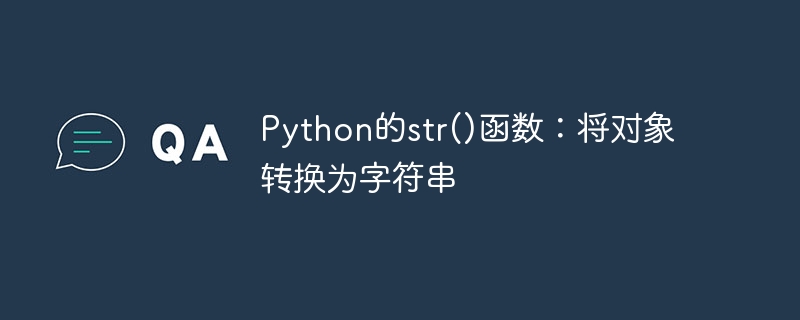

Python is a high-level programming language that is widely popular because it is easy to learn and efficient. In Python programming, processing text and strings are very common tasks. In this process, the str() function in Python plays a pivotal role. The str() function can convert any object in Python to a string. In this article, we will take an in-depth look at the use of str() function in Python while providing specific code examples.
str() function is a built-in function in Python, which converts an object to a string type and returns it. This object can be a numeric value, Boolean, tuple, list, etc. various data types in Python. In Python, the str() function can handle most data types and convert them into string-formatted text. This is a very important feature in Python because it allows developers to use text and string types for calculations and processing.
str() function syntax is relatively simple. It only takes one parameter, which is the object that needs to be converted to a string. In Python, parameters can be any Python object. The following is the syntax format of the str() function:
str(object)
Among them, object is the object that needs to be converted to a string, which can be a number, list, tuple, etc.
Now let’s take a look at specific examples of using the str() function. For the convenience of demonstration, we have selected some common Python data types, including integers, floating point numbers, Boolean types, lists, and tuples. The following is the corresponding code example:
# 将整数转换为字符串 num = 2020 str_num = str(num) print(str_num) # 将浮点数转换为字符串 float_num = 3.14 str_float_num = str(float_num) print(str_float_num) # 将布尔型值转换为字符串 bool_val = True str_bool_val = str(bool_val) print(str_bool_val) # 将列表转换为字符串 list_val = [1,2,3,4,5] str_list_val = str(list_val) print(str_list_val) # 将元组转换为字符串 tuple_val = (1,2,3,4,5) str_tuple_val = str(tuple_val) print(str_tuple_val)
After running the above code, you will get the following results:
'2020' '3.14' 'True' '[1, 2, 3, 4, 5]' '(1, 2, 3, 4, 5)'
As you can see, the str() function can convert numbers, Boolean types, lists, and Data types such as tuples are converted to strings. During this process, the value of the original data type is not modified, but converted into a new string type. It should be noted that the str() function only accepts one parameter. If you give more than one parameter, it will return an error.
The str() function in Python is a very practical function. It can convert any data type in Python to a string type, regardless of Is it a numeric type, or other Python variable types such as lists and tuples. In actual programming, we often need to convert different types of data into string types. At this time, the str() function can easily accomplish this task. When using the str() function, you need to pay attention to the type and number of parameters to avoid errors.
The above is the detailed content of Python's str() function: Convert object to string. For more information, please follow other related articles on the PHP Chinese website!




